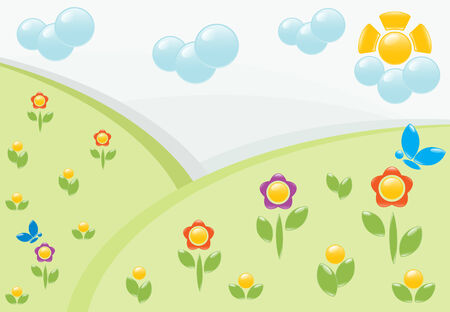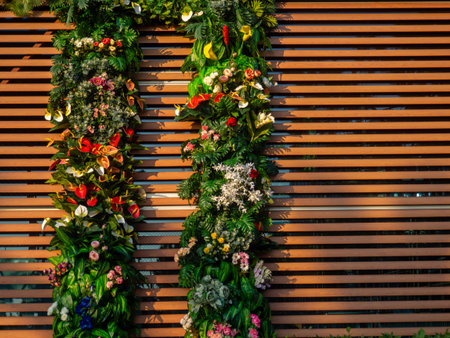Embracing Pastel Palettes: Why Soft Hues Make a Difference
Pastel colors are making waves in American flower garden design, capturing the hearts of eco-conscious gardeners seeking tranquility and sustainability. These gentle hues—think blush pinks, soft lavenders, airy blues, and pale yellows—offer more than just visual delight. By integrating pastel palettes into your garden, you’re not only creating a soothing retreat but also supporting environmentally friendly practices. Unlike bold or synthetic color schemes that often require heavy maintenance and artificial enhancers, pastel gardens thrive with native flowers and low-impact care routines. Across the United States, gardeners are discovering that these soft tones blend harmoniously with natural landscapes, attracting pollinators while minimizing chemical inputs. The result is a serene outdoor escape that nurtures both the earth and the spirit, embodying the growing American desire for spaces that promote well-being and environmental stewardship.
2. Selecting Sustainable Plants with Pastel Blooms
When designing a pastel paradise in your flower garden, choosing sustainable plant varieties is essential for both environmental health and long-lasting beauty. By selecting native and drought-tolerant flowers that thrive across different U.S. regions, you can ensure your garden flourishes with soft hues like delicate pinks, lavenders, and buttery yellows—while also supporting local biodiversity. Embracing native species not only reduces water usage but also provides vital habitats for pollinators such as bees, butterflies, and hummingbirds.
Why Native and Drought-Tolerant Plants Matter
Native plants are uniquely adapted to local climate conditions, soils, and pests, requiring fewer resources to maintain. Drought-tolerant varieties help conserve water—a crucial practice in many American regions facing increasing periods of dryness. These eco-friendly choices allow gardeners to enjoy lush pastel blooms without compromising on sustainability.
Popular U.S. Native & Drought-Tolerant Pastel Flower Varieties
| Flower Name | Pastel Color | Region Adapted | Biodiversity Benefit |
|---|---|---|---|
| Purple Coneflower (Echinacea purpurea) | Soft lavender-pink | Midwest, Eastern U.S. | Attracts butterflies & bees |
| Pale Evening Primrose (Oenothera pallida) | Buttery yellow | Western U.S., Southwest | Pollinator support; drought-hardy |
| Wild Blue Phlox (Phlox divaricata) | Pale blue-lavender | Eastern & Central U.S. | Early nectar source for pollinators |
| Prairie Smoke (Geum triflorum) | Misty pink | Northern Plains, Rockies | Bumblebee-friendly; low water needs |
| Sundrops (Oenothera fruticosa) | Lemon yellow | Southeast, Mid-Atlantic U.S. | Attracts butterflies; easy-care perennial |
| Showy Milkweed (Asclepias speciosa) | Pale blush pink | West Coast, Plains States | Essential for monarch butterflies |
Cultivating Harmony in Your Garden Design
Selecting these resilient blooms ensures that your pastel-themed garden not only dazzles with serene color but also contributes positively to local ecosystems. Mix and match species from the table above according to your region’s climate and soil type for a truly harmonious—and sustainable—pastel paradise right outside your door.

3. Designing Your Pastel Garden: Harmony Meets Habitat
When designing a pastel-themed flower garden, the goal is to balance visual serenity with environmental stewardship—a true win for both your senses and local wildlife. Begin by mapping out zones in your backyard that receive different amounts of sunlight, as this will help you select the right soft-hued flowers and native greenery for each area. Pastel blooms such as pale pink coneflowers, lavender phlox, creamy white yarrow, and baby blue forget-me-nots pair beautifully with subtle native grasses and ferns, creating a seamless flow of color and texture.
Tips for Arranging Soft-Colored Blooms
For a harmonious look, arrange plants in gentle drifts or clusters rather than rigid rows. Layer taller perennials like delphinium or foxglove at the back of beds, medium-height asters or bee balm in the middle, and low-growing groundcovers such as sweet alyssum along borders. This technique not only enhances visual interest but also mimics nature’s patterns, making your garden more inviting to pollinators.
Supporting Pollinators and Wildlife
Incorporate a variety of native plants alongside your pastel favorites—think milkweed for monarchs, wild bergamot for bees, and coral honeysuckle for hummingbirds. These selections support pollinator health while blending effortlessly into your serene palette. Choose pesticide-free options and allow some leaf litter to remain as habitat for beneficial insects.
Low-Maintenance Sustainability
Opt for drought-tolerant natives like prairie dropseed or black-eyed Susan to reduce watering needs and maintenance time. Mulch pathways with organic materials such as shredded bark or leaf mold to retain moisture and suppress weeds naturally. By focusing on local species adapted to American climates, you create a landscape that’s beautiful year-round, resilient to pests, and easy to care for—making your pastel paradise both eco-friendly and effortless.
4. Eco-Conscious Garden Materials and Mulching
Building a pastel paradise isn’t just about color—it’s about nurturing the Earth while you nurture your blooms. Choosing eco-friendly materials for paths, planters, and mulch is essential for a flower garden that’s as kind to the planet as it is beautiful. Thoughtful selections will ensure your soft-hued retreat thrives in harmony with nature and American values of sustainability.
Sustainable Pathways to Match Pastel Tones
When designing garden paths that complement gentle pinks, lavenders, or pale yellows, consider permeable materials such as reclaimed brick, recycled concrete pavers, or decomposed granite. These not only blend beautifully with a pastel palette but also reduce runoff and allow rainwater to nourish your soil. Permeable pathways prevent erosion and help maintain a healthy ecosystem right in your backyard.
Recommended Pathway Materials
| Material | Eco-Benefit | Pastel Compatibility |
|---|---|---|
| Reclaimed Brick | Reduces landfill waste | Soft red/pink hues fit pastel schemes |
| Recycled Concrete Pavers | Upcycles construction debris | Light gray tones pair well with cool pastels |
| Decomposed Granite | Natural, permeable surface | Cream/beige shades enhance soft color palettes |
Recycled Planters for Subtle Style and Sustainability
Select planters made from recycled plastics, repurposed wood, or upcycled metal to keep your garden low-impact and on-trend. These materials are widely available in the U.S. and often come in muted finishes that don’t compete with your soft floral tones. Opt for weathered finishes or paint old containers in eco-friendly pastel shades using non-toxic paints for a cohesive look.
Sustainable Planter Choices
| Planter Type | Sustainability Factor | Aesthetic Fit |
|---|---|---|
| Recycled Plastic Pots | Keeps plastics out of landfills | Easily painted in any pastel hue |
| Repurposed Wood Crates | Gives new life to old materials | Adds rustic charm with gentle colors |
| Vintage Metal Tubs/Buckets | Upcycles household items | Zinc and copper tones suit soft palettes |
Organic Mulching: Protecting Plants and Planet Alike
Avoid dyed or synthetic mulches that can clash with delicate flower colors and harm local ecosystems. Instead, choose organic options like shredded bark, leaf mold, or cocoa hulls. These naturally blend into pastel garden beds while improving soil health and moisture retention. Locally sourced mulch reduces transportation emissions—another win for eco-conscious gardeners across America.
Sustainable Mulch Options at a Glance:
- Shredded Bark: Complements creamy yellow or blush pink blooms.
- Cocoa Hulls: Offers a light brown tone that pairs well with lavender flowers.
- Pine Needles: Softens blue or white plantings with their subtle reddish-brown color.
- Leaf Mold: Earthy tones work with all pastel schemes and boost soil vitality.
By selecting sustainable paths, recycled planters, and organic mulching, you can create a serene pastel garden sanctuary that reflects both your personal style and your commitment to environmental stewardship—a true American value.
5. Seasonal Care: Keeping Your Pastel Paradise Thriving Year-Round
To ensure your pastel flower garden remains a serene oasis throughout the year, it’s essential to adapt your care routine as the seasons change. Sustainable practices not only support the health of your blooms but also nurture local ecosystems and conserve resources.
Water-Wise Irrigation Strategies
In many parts of the U.S., water conservation is key, especially during hot summers. Install drip irrigation systems or soaker hoses to deliver water directly to plant roots, minimizing waste. Mulch with organic materials like shredded leaves or bark to lock in moisture and regulate soil temperature—both crucial for pastel-hued flowers that can be sensitive to heat stress.
Composting for Healthy Soil
Nourish your garden with homemade compost created from kitchen scraps, grass clippings, and autumn leaves. Rich compost supports strong root systems and vibrant blooms, naturally enhancing those soft pinks, lavenders, and creamy yellows. Composting also reduces landfill waste and encourages beneficial microbes essential for year-round plant resilience.
Seasonal Plant Swaps for Biodiversity
Rotate annuals and perennials as the seasons shift to keep your color palette fresh while supporting pollinators and beneficial insects. In spring and fall, swap out tired plants for native varieties adapted to your local climate—think columbines or prairie phlox for early color, and asters or goldenrod as summer fades. This practice promotes biodiversity and helps your pastel paradise thrive without overtaxing resources.
Sustainable Maintenance Tips
Keep pathways clear with permeable materials like gravel or flagstone to prevent runoff. Prune gently in late winter or early spring to encourage healthy growth and avoid disturbing nesting wildlife. Embrace a “leave the leaves” approach in fall—allowing some leaf litter to remain provides habitat for overwintering pollinators and enriches soil naturally.
Eco-Friendly Year-Round Garden Success
By integrating mindful irrigation, composting, and seasonal planting strategies into your care routine, you’ll cultivate a flourishing pastel retreat that celebrates both beauty and sustainability. Every thoughtful choice helps create a resilient landscape that honors nature’s cycles—ensuring your garden remains a haven for people and pollinators alike all year long.
6. Community and Connection: Sharing Your Pastel Retreat
Your pastel paradise is more than just a visual delight—its a vibrant hub for connection, creativity, and community building. Inviting neighbors into your softly-hued garden space fosters a sense of belonging and inspires collective action toward sustainability. Consider hosting an open garden day, where neighbors can stroll through the gentle colors, exchange gardening tips, and learn about your eco-friendly choices. Use local wildflower seed packets as party favors to encourage others to plant pollinator-friendly blooms in their own yards.
Hosting Sustainable Garden Parties
Transform your pastel retreat into the perfect backdrop for a sustainable garden party. Opt for reusable or compostable dishware, serve locally sourced snacks, and use upcycled decorations like fabric bunting or repurposed mason jars as vases. Incorporate activities such as native plant swaps or DIY natural dye workshops using flower petals from your garden—these not only entertain but also educate guests about low-impact living.
Inspiring Eco-Minded Choices
Let your garden be a living example of how beauty and sustainability go hand in hand. Display signs highlighting drought-tolerant species, organic mulching methods, or rainwater collection systems you use. Encourage visitors to ask questions and share their own experiences with environmentally conscious gardening. By opening your pastel haven to the community, you plant seeds of inspiration that ripple outwards, nurturing a culture of earth-friendly gardening throughout your neighborhood.
Cultivating Lasting Connections
Sharing your pastel paradise creates opportunities for ongoing collaborations—whether it’s organizing neighborhood pollinator counts, creating a shared compost system, or launching a community seed library. Each gathering in your flower-filled oasis strengthens bonds and empowers others to embrace sustainable practices, making your pastel retreat not just a private sanctuary but a catalyst for positive change in your wider community.


